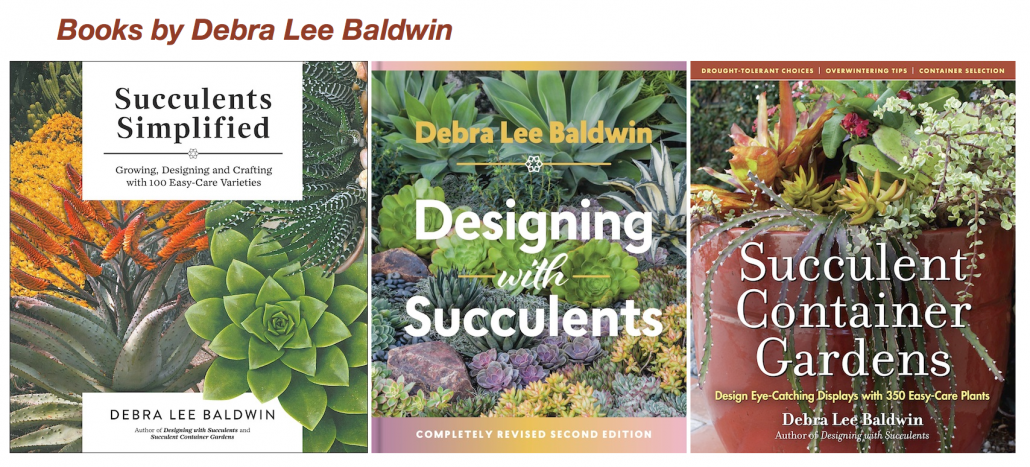
Plant an Undersea Succulent Clamshell
Undersea Succulent Clamshell Planter
Succulents that resemble coral-reef flora lend themselves to containers that immerse the viewer in an undersea experience. This succulent clamshell planter sits atop lava rocks near my home's entry. It's semi-shaded by Texas privet, the trunks of which frame the arrangement and repeat the upright lines of Senecio anteuphorbium. Certain succulents (the senecio, the aloe at left and the Medusa euphorbia) came from the original arrangement, which I made several years ago, but most are new. Those that had outgrown the planter---notably Crassula 'Gollum' and other jades---found homes in the garden.
Here's my list of plants and materials, along with my method and how to care for the arrangement once completed. This goes with my YouTube video, DIY Undersea Succulent Clamshell. Have fun!

Plants: Below are what I used, but there are so many succulents that suggest tidepool flora. Feel free to make substitutions. See "Marine Life Look-Alikes" on page 101 of Designing with Succulents (2nd ed).
Aloes that look like starfish (4 or 5, various sizes). I used Aloe maculata and in 3-inch pots, the dwarf species A. 'Christmas Sleigh', A. 'Pink Blush' and A. 'Snow Storm'.
A Medusa euphorbia. I used E. flanaganii.
Euphorbia anoplia (Tanzanian zipper plant). Mine was in an 8-inch pot.
Fenestraria aurantiaca (baby toes), two in 3-inch pots
Crassula lycopodioides (C. muscosa, watch chain), three in 3-inch pots
Senecio anteuphorbium (swizzle sticks) for height
A tillandsia (air plant)
Materials: (links go to Amazon):
Clam shell, 25" x 16.5" x 8.5" around $110 (planted ones go for $300 or more)*
Pumice, 2 qts. around $15
Potting soil, 4-qt. bag, around $10
Optional:
Rocks to anchor the rootball of the tall senecio
Soft artist's brush for removing spilled soil from plants
Chopstick for settling roots (or use the pointed end of the artist's brush)
Joyce Chen (or similar) kitchen scissors for delicate pruning
White or gray-white sand (not beach sand)
Seashells, crushed shells, pebbles and/or lava rock
DIY Method:
Fill clamshell 1/3 full of pumice. Start with your largest plants. If you're using a tall senecio with a small rootball, as I did, anchor the roots with rocks so it doesn't tip over. Add potting soil and press firmly to surround and secure rootballs. As you compose the arrangement:
-- Keep in mind it should look as though the succulents were undersea flora and fauna inhabiting a coral reef.
-- Rotate plants outward so they're facing the viewer.
-- Place tall plants in the back. Put small ones in front and use as filler.
-- Use plants and their root balls, shells, chunks of coral and/or rocks to retain soil in the clamshell's U-shaped dips.
Caring for your composition:
To make it last and look good for years, place it in bright shade where it'll get only a few hours of sun daily, ideally early morning or late afternoon. Water the plants lightly once a week in summer and once a month (or not at all) in winter.
Err on the dry side. This is a nondraining container, so don't let it sit out in the rain or get watered by automatic irrigation. Although the pumice in the bottom will absorb moisture, it's not a substitute for drainage. If the arrangement gets flooded, tip it slightly so water drains out.
Keep it tidy: Deadhead spent flowers, peel or snip off dry lower leaves, and remove debris that may fall onto or into the plants.
*How much will it cost?

This succulent-planted clamshell at Roger's Gardens is priced at $300. If you DIY, expect to pay about half that---less if you use cuttings.
Related Info on This Site:
Related Video on my YouTube channel:

See how succulents combine with bromeliads and outdoor art in this undersea-themed "mermaid's garden." The owner/designer is Nancy Englund, president of the Laguna Beach Garden Club.





